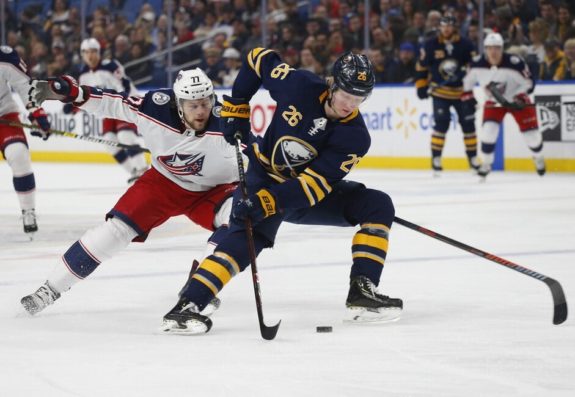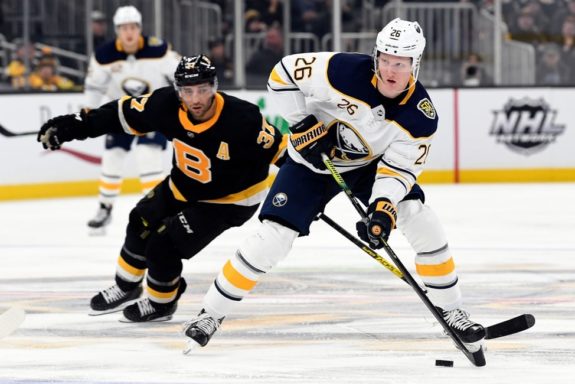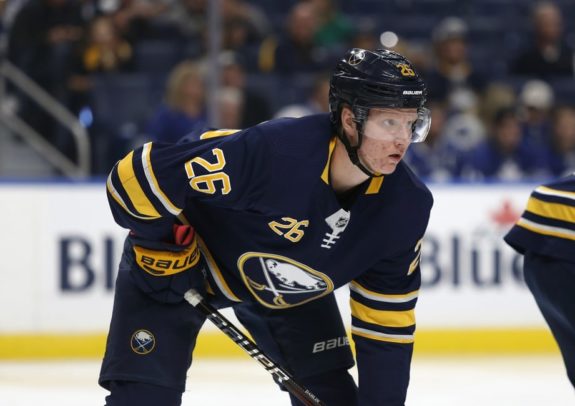It wasn’t the start we were expecting.
Coming off a historic rookie campaign, Rasmus Dahlin was poised to really put his stamp on the league. In 2018-19, the 18-year-old posted dominant numbers offensively but was also stellar in overall puck possession. This season, however, things started out differently.
Dahlin at times appeared to be lost in his own zone. His decision-making was questionable in terms of playing the puck up ice or even controlling it himself. His passes seemed a fraction slower than we were used to and his defence was questionable at best, often leaving his feet to try and defend from his knees before subsequently being beaten. This culminated in an unfortunate concussion at the hands of Erik Cernak on Nov 25.
Dahlin’s Early Numbers Highlight Struggles
Dahlin’s results to start the season didn’t necessarily support his shaky look. He was getting results while on the ice but didn’t look convincing doing so. According to Evolving-Hockey, through the first 24 games before his concussion, Dahlin was on the ice for 59.15 percent of goals for at five-on-five. Over that span, that ranked 18th in the National Hockey League among defencemen playing at least 350 minutes. He also had 1.37 points per 60 minutes at even strength which placed him 10th among NHL defencemen.
Those numbers were all great. What was troubling was the path he was taking to get there. In terms of controlling shot share, Dahlin had a Corsi for percentage (CF%) of just 49.09, ranking 69th among defencemen. More importantly, his control of quality for and against (xGF%) was very poor. He had a 39.65 xGF%, ranking 105th over that stretch among defenders.

That last stat really helps tell the story of what we were seeing with Dahlin. He was getting points, yes, but it wasn’t pretty. The confidence that looked to be a hallmark of his game was replaced with an unsteadiness that was dragging himself and his teammates down.
Dahlin was committing 2.40 giveaways per 60 and only retrieving .86 takeaways per 60 during that stretch, totaling negative 1.54 for every hour he was on the ice. In terms of penalties drawn compared to penalties taken, he was negative 0.69 per 60 minutes. He was also struggling to block shots, blocking only 2.40 shots per hour and shooting 5.26 percent. Coincidentally, his block rate seemed to perfectly jive with his giveaway rate. His quality chances, again, were not that strong with him only being expected to score .1 goals every hour.
While there is never a good time to suffer a concussion, the timing of Dahlin’s seemed to be particularly damning. The young rearguard appeared to be meeting a pivotal moment in his fledgling career.
Dahlin Bouncing Back Since Injury
After being the victim of Cernak’s flying elbow, Dahlin was forced to miss the next eight games. The defence appeared to stabilize and it looked like Dahlin was perhaps not missed very much. Such a situation may have proven advantageous in giving him all the time he needed to recover.
Since Dahlin’s return, however, there has been a noticeable difference in his game. His poise appears to have returned and his overall confidence with the puck looks to be back where it was last season. His defence has looked stronger and his ability to break up plays has been bolstered. The difference can also be seen in his numbers.

His control of the shot share has been relatively similar at five-on-five with a 49.22 CF%. Where the biggest difference is seen is in his ability to control quality for and against. Since returning from injury, Dahlin owns a 52.32 xGF%, a jump from 105th to 42nd in the league over that time among defenders playing at least 120 minutes.
Dahlin looks ready now to carry the puck when need be. For the majority of the early season, it looked as though only Jack Eichel and occasionally Marcus Johansson were able to carry the puck across multiple zones into the attacking end. Since returning, Dahlin has played with the creativity and brashness that allowed him to move north around opponents with ease through his first 82 games.
Dahlin’s giveaway-takeaway ratio has improved slightly at now negative 0.95 per 60 minutes. Last season, he was minus-1.2 per 60. This may just be a reality for the young stud who thrives on carrying the puck and pushing it up ice. A safer player may have a stronger giveaway-takeaway ratio but won’t be able to create all of the other things that Dahlin does.
His blocks per hour are now 3.32, nearly half a block more than each giveaway he commits. A noticeable increase in his penalties-drawn rate has been seen with him going from negative-0.69 penalties per 60 to plus-0.75. No doubt much of the frustration from his early season struggles is beginning to dissipate, resulting in fewer dumb infractions. His individual xGF/60 also went from 0.1 to 0.32, good for 11th in the league since returning!

What’s interesting to note is the general direction the team is going. With Dahlin’s improved play, it would seem reasonable to believe that he would be on the ice for a greater percentage of his team’s goals. On the contrary, his GF% dropped from 59.15 percent to 49.84 percent. This is more of a function of the team over-performing at the start of the year and now getting fewer bounces.
Dahlin’s personal point totals look very encouraging. As he has shown more of a focus on his defensive game, his scoring rate has stayed strong. He ranks 24th amongst defenders playing at least 120 minutes in points per hour since returning. This is in conjunction with his team being dead last in the league in goals per 60 since his return. The team is the bottom of the barrel in the league and he is still upper echelon among defencemen. If his team ever makes a move for a forward, we could really tap into his true potential.
Expectations For Dahlin Going Forward
The upward trajectory for Dahlin is plain to see. While this season did not kick off the way that anyone was hoping, the 19-year-old has slowly been regaining his dominant style of play.
All of the talk this season has been about young defenders Cale Makar and Quinn Hughes. Both have had excellent starts to their respective NHL careers. What needs to be kept in mind though, is just how young Dahlin is in comparison. Makar is over a year and a half older than Dahlin and even Hughes is seven months older. At such a young age, a few months can make a big difference in terms of their physical and mental development. What Dahlin has accomplished on such a low-scoring team is incredible.

The Sabres are blessed to have the services of Eichel and Dahlin going forward. Eichel has put himself in Hart Trophy consideration and should continue to do so for the next few seasons. As early as next season, Dahlin could begin entering the conversation of annual Norris Trophy candidates.
As for this season, Dahlin is currently on a 0.66 points-per-game pace which would have seen him finish with 54 points had he not been injured. We can expect him to continue driving play from the defensive zone and stymying attackers as they enter the Sabres’ end. Whether it’s due to him gaining a better grasp of Ralph Krueger’s system or benefiting more from his new pairing with Brandon Montour instead of Colin Miller, he is undoubtedly gaining traction. If he ever gets a stronger supporting cast up front, he could truly turn into something extremely special — even more than he already has.